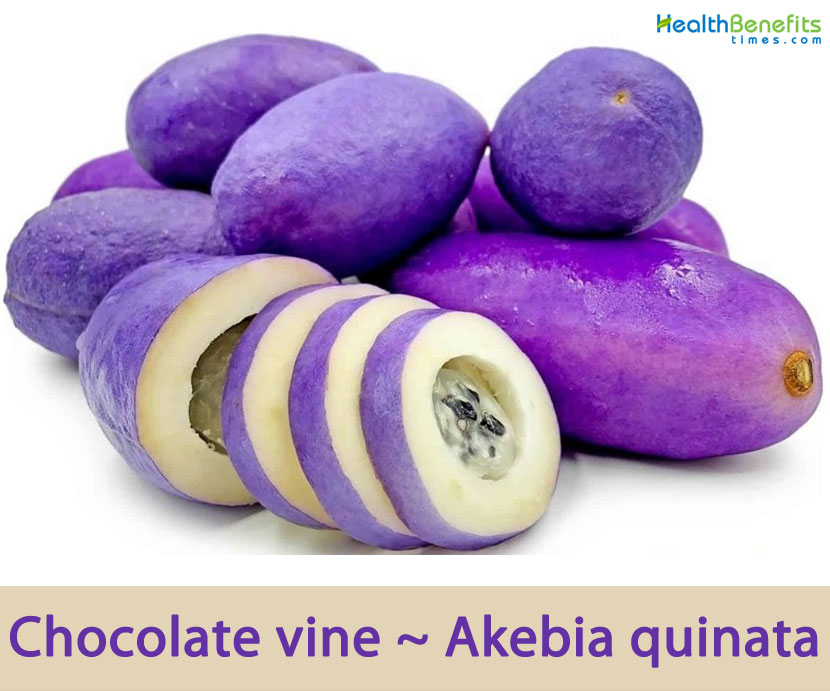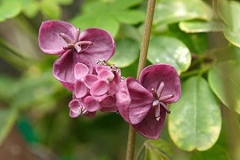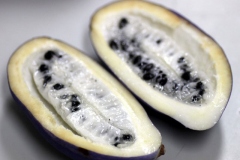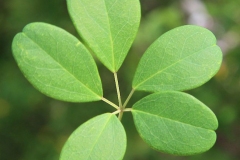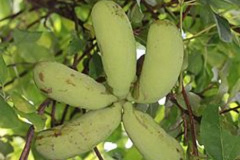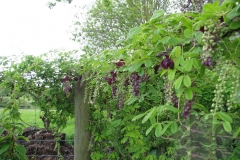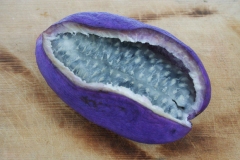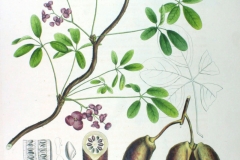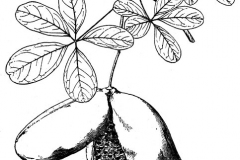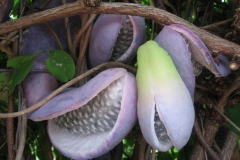| Chocolate vine Quick Facts | |
|---|---|
| Name: | Chocolate vine |
| Scientific Name: | Akebia quinata |
| Origin | Japan, China and Korea |
| Colors | Initially light green, turning pink to purplish with lighter speckles |
| Shapes | Uncommon, large, soft, edible sausage-shaped pods are straight or slightly incurved, oblong to ellipsoid about 2 to 4 inches (5 to 10 cm) long |
| Flesh colors | Whitish |
| Taste | Bitter |
| Health benefits | Beneficial for amenorrhea, problems related to the breast, diabetes, dropsy, cold, headaches, general weakness, hernia, lumbago, Uti, scanty lactation and rheumatoid arthritis |
| Name | Chocolate vine |
|---|---|
| Scientific Name | Akebia quinata |
| Native | Japan, China and Korea, and invasive in the eastern United States from Georgia to Michigan to Massachusetts |
| Common Names | Akebi, Eureumdeonggul, Mu tong fruit, Urum, Five leaf akebia, Chocolate Vine, Raisin vine, Five-leaf |
| Name in Other Languages | Arabic: أكيبيا كويناتا Bulgarian: Akebiya kuinata (Акебия куината) Aromatni tsvetove (Ароматни цветове), Dekorativni plodove (Декоративни плодове), shokoladova loza (шоколадова лоза) Chinese: Mu tong ( 木通) bai mu tong, son ye mu tong Danish: Femfingret akebia Dutch: Klimbes, Schijnaugurk, Klimaugurk English: Chocolate vine, Five-leaf akebia, Raisin vine, Five-leaf Finnish: Akebia, Kastanjaköynnös, Rinneakebia French: Akébie à cinq feuilles, Akébia, feuilles German: Fingerblättrige akebie, fuenfblaettrige akebie Hungarian: Ötlevélkéjű akébia Japanese: Akebi (アケビ), yusura-ume (ユスラウメ) Korean: Euleum (으름) Urum, eureumdeonggul (으름덩굴) Lithuanian: Penkialapė akebija Netherlands: Klimbes, schijnaugurk Persian: مو شکلاتی Polish: Akebia pięciolistkowa Russian: Akebia kuinata (Акебиа куината), Akebiya pyaternaya (Акебия пятерная), Shokoladova loza (Шоколадова лоза), akebia pyaternoye Serbian: Akebija (Акебија), petosilna akebija (петосилна акебија) Swedish: Fembladig akebia Turkish: Çikolata sarmaşığı |
| Plant Growth Habit | Invasive, vigorous, fast growing, woody, deciduous to evergreen climbing, trailing vine or groundcover |
| Growing Climates | Woods, hedges and thickets in mountainous areas, forest margins along streams, scrub on mountain slopes, forest edges, streams banks , forest lands |
| Soil | Prefers light, medium, and heavy soils but requires a well-drained yet moist soil |
| Plant Size | 40 feet (12 m) long |
| Stem | Stems are greyish brown, slender and cylindrical with small, prominent lenticels that have the shape of a flat ring or disk. They are thin and green when young but turn brown and somewhat woody as the plants mature |
| Bark | Reddish to gray-brown, developing interlacing ridges and furrows |
| Twigs | Slender, red-brown; buds small, imbricate, rounded to wedge-shaped and reddish-brown; leaf scars raised with 6 or more bundle scars |
| Leaf | Leaves are alternate along the stems or cluster on the branchlets and are divided into five, or sometimes three to four or up to seven leaflets. |
| Flowering season | April to May |
| Flower | Flowers are monoecious, apetalous, with both staminate (male) and pistillate (female) flowers appearing in the same raceme. Flowers are often hidden by the foliage, but are quite interesting on close inspection and have a pleasant fragrance |
| Fruit Shape & Size | Uncommon, large, soft, edible sausage-shaped pods are straight or slightly incurved, oblong to ellipsoid about 2 to 4 inches (5 to 10 cm) long, tipped like a banana |
| Fruit Color | Initially light green, turning pink to purplish with lighter speckles |
| Flesh Color | Whitish |
| Seed | Ovoid-oblong and compressed |
| Propagation | By Seed, Cutting, Division |
| Taste | Bitter |
| Plant Parts Used | Fruit, Stem, leaves and roots |
| Season | September to October |
Plant Description
Chocolate vine is an invasive, vigorous, fast growing, woody, deciduous to evergreen climbing, trailing vine or groundcover plant that normally grows about 40 feet (12 m) long. The plant is found growing in woods, hedges and thickets in mountainous areas, forest margins along streams, scrub on mountain slopes, forest edges, streams banks and forest lands. It prefers light, medium, and heavy soils but requires a well-drained yet moist soil. Twigs are slender, red-brown; buds are small, imbricate, rounded to wedge-shaped and reddish-brown. Leaf scars are raised with 6 or more bundle scars. Bark is reddish to gray-brown, developing interlacing ridges and furrows.
Stem
Stem is woody, round, to 4 inches (10 cm) in diameter at the base, with numerous branching stems twining for support on plants or natural trellises or forming ground cover and rooting where nodes contact soil. Lime green and smooth, becoming dotted with many brownish dots (lenticels), then light and dark gray striated and finally light gray speckled with raised gray dots. Leaf scars are circular and cleft, protruding alternately or in clusters along the stem. Divergent buds are a dark rich brown at maturity with glabrous imbricate bud scales. Bark of old stems are fairly smooth compared to many vines with gray-brown color to gray flushed with an overall purplish haze.
Leaves
The petiole is slender about 4.5–10 cm. Its petiolules are slender 1.5 –2.5 cm. Leaves have several leaflets typically 5–7 whose midribs all radiate from one point. The leaves are alternate along the stems or cluster on the branchlets and are divided into five, or sometimes three to four or up to seven leaflets. The papery leaflets are obovate to obovate-elliptic. The leaflets are abaxially glaucous (whitish underneath), adaxially dark green (dark green above) with bases which are rounded to broadly cuneate. The apex, that is the point furthest from the point of attachment, is rounded and usually emarginated (notched) or cuspidate (with a point). The lateral leaflets measure 2–5 cm long and 1.5–2.5 cm wide, while the terminal leaflets are 2.5–7 cm. The racemes are clustered or bundled together measuring 6–12 cm.
| Leaf Arrangement | Alternate |
| Leaf Venation | Palmate |
| Leaf Persistence | Evergreen |
| Leaf Type | Palmately Compound |
| Leaf Blade | 5 – 10 cm |
| Leaf Shape | Oblong |
| Leaf Margins | Entire |
| Color(growing season) | Green |
| Color(changing season) | Green, Purple |
Flower
Flowers are monoecious, apetalous, with both staminate (male) and pistillate (female) flowers appearing in the same raceme. Flowers are often hidden by the foliage, but are quite interesting on close inspection and have a pleasant fragrance. The plant produces staminate and pistillate flowers that are found in pendulous, racemose clusters. Male flowers are 4–8(–11) mm. The stem that attaches single flowers to the main stem slender is 7-10 mm with three sepals 3(-5), pale purple, occasionally pale green or white, broadly cucullate-ovate, 6–8 mm long and 4–6 mm wide, apex rounded. Stamens 6 (or 7) are straight at first, incurved at length; filaments very short; anthers oblong. Pistillodes 3–6, small. Female flowers are pedicel slender, 2–4(–5) cm. Sepals are dark purple, occasionally green or white, broadly elliptic to sub orbicular, 1–2 cm long and 0.8–1.5 cm.
Although both male and female flowers are present in the racemes, there appears to be a degree of self-sterility and more than one clone is necessary for good fruit set. Flowers tend to open at night and are only of minor visual effectiveness, but are valued for their strong vanilla fragrance. Flowering normally takes place in between April to May.
| Flower Showiness | True |
| Flower Size Range | 1.5 – 3 |
| Flower Type | Raceme |
| Flower Sexuality | Diecious (Monosexual) |
| Flower Scent | Pleasant |
| Flower Color | Brown, Red, Purple, White |
| Seasons | Spring |
Fruits
Fertile flowers give way to dangling clusters of 1 to 5 sausage-shaped, fleshy violet fruit pods. It is 2 to 4 inches (5 to 10 cm) long, tipped like a banana and having a lengthwise suture along one side which split open in fall to reveal small black seeds. Fruits are initially light green, turning pink to purplish with lighter speckles and a waxy coating as they mature. Fruit starts ripen in late September to early October. When ripe the skin splits to reveal a pulpy, edible inner core that splits further to expose many (100+) imbedded black seeds in a whitish pulp. The whitish pulp is edible. Seeds are ovoid-oblong and compressed. Seed coat is brown to black and shiny.
| Fruit Type
|
Follicle |
| Fruit Size Range | 7 – 10 |
| Fruit Colors | Purple, Blue |
| Seasons | Spring |
| Fruit Showiness | True |
Health benefits of Chocolate Vine
Listed below are some of the popular health benefits of chocolate vine
1. Metal disorders
Pills made with Chocolate vine seed (peeled), white poria, boxthorn seeds, Acorus tatarinowii root, poria with hostwood, platycladi seed, cortex lycii radicis, polygala tenuifolia, Chinese yam, roots of polygonatum (steamed), cinnabar and honey is taken orally with ginseng soup to treat metal disorder.
2. Eyebrow loss
Decoction of Chocolate vine seed, realgar and mastic is taken with wine to treat eyebrow loss.
3. Pain relieving
Decoction of Chocolate vine, poria cocos, ophiopogon root and pumice can be used as a remedy for hernia caused penis pain.
4. Excretory System
Decoction of cynanchum paniculatum, couch grass rhizome, akebia stem, chingma abutilon seed, soapstone, betel nut, dianthus superbus and sodium sulfate can be used to treat difficulty with urination.
A decoction of juncus effusus stem, akebia stem, dianthus superbus and plantain seed is taken orally to reduce internal fever and promote diuresis.
5. Anti-inflammatory
Chocolate vine is a very good anti-inflammatory agent which helps with arthritis, joint pain, back pain, lumbago swelling, and redness.
6. Induces Menstruation
This herb also helps to bring about monthly periods thus regulating menstruation.
7. Powerful Diuretic
Chocolate vine is a very good diuretic which helps with water retention and urinary challenges.
8. Great for Headaches
Chocolate vine also helps with headaches and migraines when taken as a tea.
9. Anti-tumor Agent
New studies are being done about using Chocolate vine for the treatment of breast and digestive tract tumors.
10. Helps with Weakness
Chocolate vine also helps with general feelings of weakness helping to strengthen the body in general.
11. Inflamed Kidneys and Stomach
Chocolate vine is a great agent for soothing away irritations of the stomach and kidneys thus helping to prevent further disease.
12. Great for the Liver
Being a good anti-inflammatory agent Chocolate vine also helps to detox and soothe the liver.
13. Antibiotic
Chocolate vine is also a good antibiotic herb for getting rid of bacterial infections.
14. High in Potassium
Chocolate vine is also high in potassium for good heart contractions and water regulation.
15. Lowers Fevers
Chocolate vine roots can be made into a tea that works well for lowering fevers.
16. Powerful Pain Reliever
The dried stems made into a tea are a very good for getting rid of pain.
17. Mouth Sores
Chocolate vine used as a tea is also great for treating mouth irritation and sores.
18. Painful Urinary Infections
Chocolate vine also works well for getting rid of painful urinary tract infections.
19. Increases Circulation
Chocolate vine increases circulation to all parts of the body including the heart.
20. Helps with Skin Challenges
This herb also works well for skin rashes, irritations, and pain and swelling of the skin.
Traditional uses and benefits of Chocolate vine
- Stems are anodyne, antifungal, anti-phlogistic, bitter, diaphoretic, diuretic, emmenagogue, febrifuge, laxative, galactogogue, resolvent, and stimulant, stomachic and vulnerary.
- When taken internally, it controls bacterial and fungal infections and is used in the treatment of urinary tract infections, lack of menstruation, to improve lactation etc.
- The fruit is anti-rheumatic, depurative, diuretic, febrifuge, stomachic and tonic.
- It has a use in traditional medicines in which urinary tract infections, scanty lactation and rheumatoid arthritis are treated.
- Fruits have been shown to have stimulatory effects on blood circulation and to have anticancer properties.
- The dried stems are used in the form of an analgesic, antiphlogistic and diuretic.
- In China, practitioners of herbal medicine also recommend this drug in the form of a diuretic as well as an anti-phlogistic for treating conditions like amenorrhea, problems related to the breast, diabetes, dropsy, cold, headaches, general weakness, hernia, lumbago, and rheumatism, in addition to inflamed kidneys and stomach.
- The herb is also effective for inducing lactation and menstruation.
- Root of Chocolate vine is used in the form of an anti-pyretic substance.
- Dried stems can be taken internally to treat both fungal and bacterial infections.
- Roots are known for their cooling properties that help alleviate fever.
- Fruits are also noted for their anti-tumor properties and are widely recognized as a natural treatment for various types of cancer.
- Pills made from its seeds and other essential herbs are traditionally taken with ginseng soup to address different mental disorders.
- Decoction made from Chocolate vine stems may help relieve pain related to hernia.
- The herb is generally taken as a remedy to menstrual issues.
- The plant is commonly used as a remedy to various other diseases including diabetes, dropsy, cold, and headache as well as lumbago and general weakness.
- Chocolate vine improves the body’s digestive and cardiac profiles.
- Chocolate vine supports both male and female reproductive health.
Culinary Uses
- Fruit can be consumed raw.
- Bitter skin of the fruit is fried and eaten.
- Leaves are used as a tea substitute.
- Rind, with a slight bitter taste, is used as vegetable, e.g., stuffed with ground meat and deep-fried.
- Soft young shoots are used in salads or for salt pickling.
- The empty pod is stuffed and deep fried.
- The fruit is also used to make wine.
Other Facts
- The plant was ranked 13th in a survey of 250 potential antifertility plants in China.
- Peeled stems are very pliable and can be used in basket making.
- Plants have sometimes been used as a ground cover, but their method of growth does not really lend themselves to this use.
- Chocolate vine is a specimen plant used in ornamental gardens and managed landscapes.
- Chocolate vine seeds produce oil used in traditional soap making in China.
- Chocolate vine has also been used in the form of a groundcover.
Prevention and Control
Due to the variable regulations around (de)registration of pesticides, your national list of registered pesticides or relevant authority should be consulted to determine which products are legally allowed for use in your country when considering chemical control. Pesticides should always be used in a lawful manner, consistent with the product’s label.
Control
Physical/Mechanical Control
Vines of Chocolate vine which are growing on the ground can be pulled by hand. For climbing vines, first cut the stems near the ground to kill the upper portions in the tree canopies. The plant below the cut will remain alive and must be pulled repeatedly over many growing seasons. Young vines that regrow can be cut any time of year using a weed whip or mower. Vines must be cut down repeatedly over several years until no regrowth occurs. Thorough mulching may be an additional tool to suppress regrowth after an initial pulling and cutting.
Chemical Control
Treatment with 2-4% triclopyr in water can be applied to control Chocolate vine. Best results occur when treated during spring/early summer many desirable plants are present during this time. Therefore a fall/dormant treatment followed by spot treatments during the growing season are often advisable. To control climbing vines in trees, cut large stems and immediately treat the stumps with an herbicide, triclopyr or a glyphosate. A subsequent foliar application of may be required to control new seedlings and any re-sprouts.
References:
https://www.itis.gov/servlet/SingleRpt/SingleRpt?search_topic=TSN&search_value=18857#null
https://npgsweb.ars-grin.gov/gringlobal/taxon/taxonomydetail?id=2103
https://pfaf.org/user/plant.aspx?latinname=Akebia+quinata
https://www.cabi.org/isc/datasheet/3933
http://www.missouribotanicalgarden.org/PlantFinder/PlantFinderDetails.aspx?kempercode=a149
https://plants.usda.gov/core/profile?symbol=AKQU
https://aggie-horticulture.tamu.edu/syllabi/608/Lists/Fourth%20Edition/Akebiaquinata.pdf
https://en.wikipedia.org/wiki/Akebia_quinata
http://www.narc.gov.jo/gringlobal/taxonomydetail.aspx?id=2103
https://davesgarden.com/guides/pf/go/369/#b
https://enacademic.com/dic.nsf/enwiki/11533911
http://www.theplantlist.org/tpl1.1/record/kew-2627104
http://www.iucngisd.org/gisd/species.php?sc=188
https://gd.eppo.int/taxon/AKEQI
http://dendro.cnre.vt.edu/dendrology/syllabus/factsheet.cfm?ID=948


